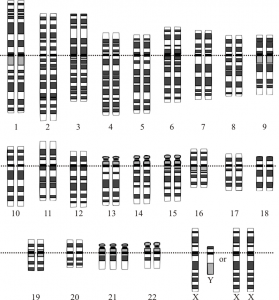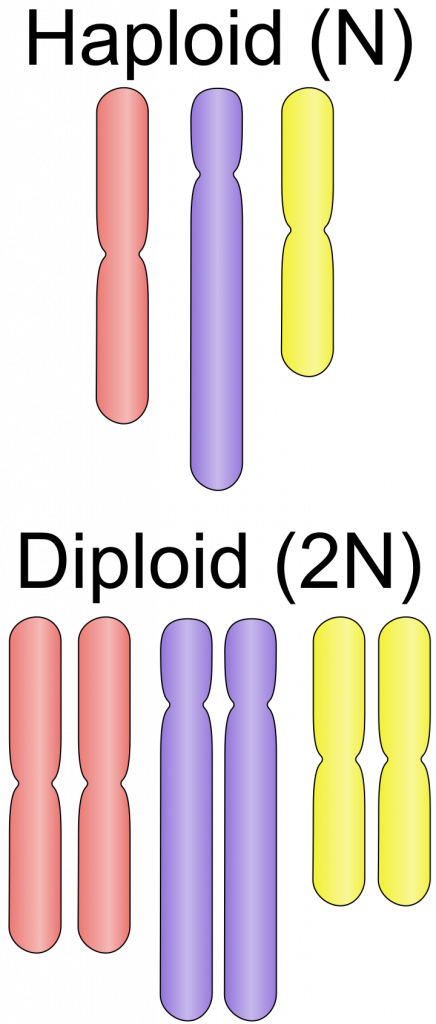Reviewing Genetics
The traits expressed by all living organisms are controlled by genes. These genes are inherited from the organism’s parent/s, and control everything from species to morphology. Genes are located on chromosomes, which are the structural organization of DNA found in nuclei in eukaryotes and nucleoli in prokaryotes. The study of these chromosomes, the genes they contain, and their heredity, is what is together known as genetics.
Gregor Mendel is known as the father of genetics. In the 1860’s, an Augustinian monk known as Mendel spent ten years studying trait inheritance in pea plants. By crossing plants with differing heights and flower colors, he was able to determine that such traits are passed from parent to offspring. Not only this, but the resultant exhibited trait is a combination of that exhibited by the parent plants. As such, he was able to state that traits are inherited by two versions of a gene, which interact to produce a phenotype in offspring. This is shown in the table below. Certain gene versions are dominant over others: for example, the tall version is dominant over the short version of the gene, meaning that if the offspring contains a tall version and a short version of a gene, the offspring will be tall. Offspring will only be short if both versions inherited are short. These versions are what we call alleles.
Table 1: The offspring produced by different combinations of Mendel’s pea plants.
| Tall parent (T) | Short parent (t) | |
| Tall parent (T) | Tall offspring (TT) | Tall offspring (Tt) |
| Short parent (t) | Tall offspring (Tt) | Short offspring (tt) |
After Mendel’s work on pea plants and genetic inheritance, further researchers determined that chromosome numbers are set in each species. In most eukaryotes, the number exhibited is known as the diploid number (2n), or two complete sets of chromosomes: one inherited from each parent. All the members of a species usually have the same chromosomal number. The table below shows the diploid chromosome number of several well-known species.
Table 2: The diploid chromosome number of several well-known species of plants and animals.
| Species | Diploid chromosome number (2n) |
| Human | 46 |
| Cat (domestic?) | 38 |
| Dog | 78 |
| Mouse | 40 |
| Potato | 48 |
| Tomato | 24 |
| Wheat | 42 |
| Chimpanzee | 48 |
This research later gave rise to the chromosomal theory of inheritance, which states that traits displayed in offspring are inherited from parents, and are controlled by genes found on chromosomes, passed to the offspring from the parents via gametes.
Genetic variation occurs when the gene controlling a trait mutates to produce a new variant or recombines to produce a new variant. An example of this would be white eyes in fruit flies.
Organisms inherit two copies of a gene, one from each parent. These copies are known as alleles. There are different levels of interaction between these alleles, which determine which copy of the gene will be expressed. Dominant traits are expressed over recessive traits (such as the example of Mendel’s pea plants above). The law of independent assortment governs how two contrasting traits, each with their set of alleles, is expressed. Occasionally two or more genes influence a single trait, leading to degrees of expression of that trait, such as coat color in Labradors. This is referred to as incomplete or partial dominance. Genes located on the X-chromosome are expressed differently in male and female offspring, as the male offspring has only one allele for this trait. Codominant alleles are expressed simultaneously, such as MN blood groups in humans. The ABO blood groups in humans are controlled by multiple alleles in the population, up to four of which can be transferred to the offspring by the parents. Also, certain alleles are lethal. These can be lethal recessive mutations, where a double copy of this allele will kill the organism, but a recessive lethal copy will be masked by the other “healthy” copy. One allele with a dominant lethal mutation is enough to result in the death of an organism. Temperature and environmental variables can also affect gene expression.
Alternating Life Cycles
Some organisms like fungi have alternating life cycles where both haploid and diploid forms occur naturally in nature called alternation of generations. The fruiting structure (teleomorph) of the fungus produces spores (unit of asexual reproduction adapted for dispersal). This unit is capable of making hyphae and forming free living haploid individuals through continued cell division. These hyphae can create asexual haploid colonies. On the other hand, these units can fuse through a process of karyogamy (nuclear marriage) and form sexual diploid free living individuals. Some fungi are heterothallic, capable of sexual reproduction without requiring another partner. While some other fungi are homothallic, requiring another individual with a different mating type to reproduce sexually reproduce. This is depicted in the figure below.
Figure 1: The alternating life cycle of fungi

Chromosome Sets
Diploid refers to the number of complete chromosome sets present in each cell of an organism: diploid cells contain two complete sets. Haploid organisms, on the other hand, only contain one complete chromosome set.
Chromosome sets can be altered in meiosis, and occasionally in mitosis. In meiosis, the chromosome number is reduced. Chromosome sets are initially doubled to create tetraploid cells (4n). The process of meiosis, which produces sex cells, splits the 4n parent cell into four haploid (n) daughter cells, which can then be combined in sexual reproduction to form a diploid offspring. In mitosis, the chromosomal number is conserved. Chromosome sets are initially doubled to create a 4n cell. Mitosis then splits the parent cell into two daughter cells with equal chromosome sets of 2n. In mitosis, the daughter cells contain the same genetic information as the parent cell, whereas in meiosis each daughter cell contains only half of the genetic information of the parent cell, allowing for genetic recombination in the offspring.
What Would Happen if this Chromosome Doubling and Reduction Did Not Occur?
In meiosis, if chromosome doubling did not occur prior to cell division, each of the four daughter cells would only contain a quarter of the chromosomes of their parent cell – so a diploid parent cell would produce four cells with only half a chromosome set. When these sex cells combined to form offspring, the offspring would only be haploid, and so would be a different species to the parent and so unable to breed. In mitosis, if chromosome doubling did not occur prior to cell division, each of the two daughter cells would only contain one chromosome set from their parent cell. This would result in an individual with cells of differing chromosome numbers, which would result in genetic mutations. If chromosome reduction did not occur in meiosis, the combination two cells to form offspring would result in offspring with double the number of chromosomes of either of its parents or a 4n chromosomal set. This offspring would then be another species. If chromosome reduction did not occur in mitosis, the resultant daughter cells would each contain a 4n chromosomal set, and so would be incompatible with the rest of the organism.
What Happens When the Chromosomal Number is Not Maintained?
The processes of mitosis and meiosis are structured to ensure that the number of chromosomes of the offspring reflects that of the parent. However, sometimes things go wrong, and this is not the case. Nondisjunction occurs when karyokinesis does not occur properly: chromosomes fail to separate into their sister chromatids, resulting in daughter cells with unequal numbers of chromosomes. Monosomy occurs after nondisjunction, in the daughter cell containing fewer chromosomes – this cell will contain one fewer chromosome or one chromosome where it should contain two. The other daughter cell will exhibit trisomy – it will contain one extra chromosomeor three chromosomes where it should contain two. Polyploidy occurs when a cell contains more than two haploid chromosome sets (such as triploid or tetraploid cells). Autopolyploidy means that more than two haploid chromosome sets of the same species are present; this can occur as a result of incomplete segregation in meiosis, or if two sperm cells fertilize the same egg cell. Allopolyploidy results when the parent cells are not of the same species, resulting in a daughter cell containing a complete diploid chromosome set from each parent cell. An example of this is a mule, which is a cross between a horse and a donkey. Such organisms are usually sterile. The result of these events is aneuploidy or a cell that does not contain a diploid chromosome number. This is the basis of many genetic diseases, such as Down syndrome (resulting from trisomy), or Edwards syndrome (also resulting from trisomy).
Figure 2: The full chromosome set of a woman with Down syndrome. Trisomy occurs on the 21st chromosome.

Other abnormalities in chromosome sets include a change in the arrangement of the chromosomal set. A deletion of part of a chromosome, in humans, can lead to diseases such as cri du chat syndrome; a repetition of part of a chromosome resulting from unequal crossing over of genetic material during meiosis. Inversions of gene sequences, translocations of chromosome segments, can result in familial Down syndrome in humans; and fragile sites in chromosomes, such as Martin-Bell syndrome in humans, a common cause of mental retardation.
What is the Difference Between Haploid and Diploid? What Does it Mean?
A haploid chromosome set occurs in eukaryotes when a sex cell or gamete is produced. This cell contains half of the genetic material, or chromosomes, of its parent cell.
A diploid chromosome set occurs in most eukaryotes in somatic cells – that is, non-sex cells. These cells contain the entire set of genetic material, or chromosomes, of the organism, or double the haploid chromosome set. Thus, the entire gene set of an organism is located in every cell of that organism.
The depiction of the diploid chromosome set of an organism is known as a karyotype. The karyotype is organized by the order of the size of the chromosomes and the location of the centromere.
Figure 3: Karyotype of a human male, showing a diploid chromosome number of 46.

Wrapping Up Haploid vs. Diploid
Diploid and haploid cells and organisms occur in nature. The differences between haploid and diploid chromosome sets are in the number of chromosomes present, and in the types of cells in which they occur. Haploid cells contain half the chromosome count of diploid cells, and are mostly germ cells, whereas diploid cells are somatic cells. Some organisms have a haploid and a diploid life cycle, such as algae. Diploid cells reproduce via mitosis creating daughter cells identical to the parent cells and each other. Haploid, on the other hand, reproduce via meiosis producing offsprings or cells different from other parent but containing a little bit of each parent and each cell different from the other.
Let’s put everything into practice. Try this Biology practice question:
Looking for more Biology practice?
Check out our other articles on Biology.
You can also find thousands of practice questions on Albert.io. Albert.io lets you customize your learning experience to target practice where you need the most help. We’ll give you challenging practice questions to help you achieve mastery in Biology.
Start practicing here.
Are you a teacher or administrator interested in boosting Biology student outcomes?
Learn more about our school licenses here.









